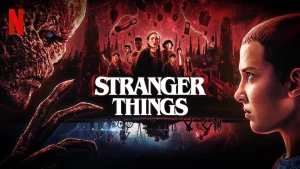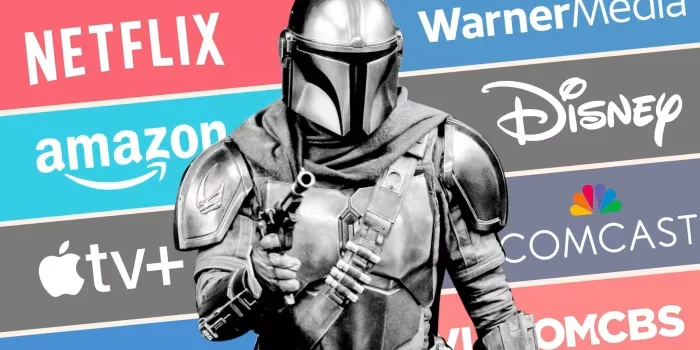
Introduction
The ongoing Streaming Wars have fundamentally transformed how people consume media. With an increasing number of streaming platforms like Netflix, Disney+, Amazon Prime, and HBO Max battling for dominance, the future of entertainment is being reshaped. This article explores how these streaming wars will reshape the media landscape, their impact on content creation and distribution, and the potential winners and losers in this battle.
The Rise of the Streaming Wars

1. From Cable to Streaming
With more customers choosing streaming services over cable and satellite, the old television business has been gradually eroding. Streaming offers convenience, variety, and on-demand access, making it an attractive option for audiences worldwide. This shift from traditional cable has triggered a competitive landscape where both new and old players are vying for attention.
2. Key Players in the Streaming Wars
Several major platforms are competing for dominance in the streaming industry. Netflix, a pioneer in the space, was among the first to disrupt the market, but competition has grown fierce. Disney+ entered the market in 2019 with its vast library of iconic content, while Amazon Prime and HBO Max have also been gaining ground. Newer services like Apple TV+ and Peacock are trying to carve out their own niches.
Streaming Changes the Way We Watch TV
Streaming has completely changed how we watch TV. In the past, we had to wait for a show to air at a specific time. Now, with streaming, we can watch anything we want, whenever we want. This freedom is one of the main reasons people love streaming services. It gives viewers control over what they watch and when they watch it, making entertainment more convenient and enjoyable.
Binge-Watching: A New Habit
With entire seasons of shows being released at once, binge-watching has become a popular way to consume content. Instead of waiting for a new episode each week, people can now watch multiple episodes in one sitting. While this is great for viewers who want to watch their favorite shows quickly, it has also changed how stories are told. Some shows are now designed to be watched all at once, with cliffhangers that keep viewers hooked.
The Competition Among Major Players
As more streaming services launch, competition has become fierce. Platforms are investing billions of dollars to secure exclusive rights to popular movies and shows, develop original content, and attract subscribers. Netflix, for instance, has invested heavily in producing its own shows and films, while Disney+ has leveraged its extensive catalog of beloved franchises like Marvel and Star Wars.
This competition is also driving innovation. Streaming platforms are constantly upgrading their user interfaces, offering features like offline downloads, personalized recommendations, and interactive viewing experiences to stand out from the competition.
The Role of Technology in Streaming
Technology plays a big role in the success of streaming platforms. High-quality streaming, personalized recommendations, and ease of use are important factors in attracting subscribers. Many platforms use algorithms to suggest shows and movies based on a user’s viewing habits. The rise of 4K, HDR, and virtual reality is also changing how we experience content, offering viewers an immersive and interactive experience.
Impact on Content Creation

1. Increased Demand for Original Content
As streaming platforms seek to attract and retain subscribers, there is a growing demand for original content. Companies are investing billions into producing new films, TV series, and documentaries. This competition has led to a surge in diverse storytelling and risk-taking, allowing creators to experiment with new formats and genres.
2. Global Expansion of Content
Streaming services are no longer limited to regional or national markets. Platforms like Netflix and Amazon Prime are expanding their reach globally, producing content in various languages to cater to international audiences. This globalization of content is transforming the entertainment industry, bringing stories from different cultures to viewers worldwide.
Growing Competition in the Streaming Market
With more streaming platforms launching every year, the competition keeps getting tougher. Netflix, Disney+, and Amazon Prime Video were early leaders, but newer players like Peacock and Apple TV+ are now fighting for their share. These services are all competing to offer the best shows, movies, and exclusive content to win over viewers. This intense rivalry is great for consumers, who now have more options than ever before.
Price Wars: How Costs Are Changing
As the number of streaming services grows, so does the cost for viewers. Many people now subscribe to multiple platforms, which can add up quickly. To attract and keep subscribers, some services are lowering their prices, while others are offering ad-supported options for a cheaper rate. This price competition may lead to even more affordable options in the future, but it could also force smaller companies out of the market if they can’t keep up.
The Decline of Movie Theaters
Movie theaters are another segment of the media industry feeling the effects of the streaming wars. The COVID-19 pandemic accelerated the decline of theaters, as many studios chose to release films directly to streaming platforms. Even as theaters have reopened, many consumers prefer the convenience of watching new releases at home.
Streaming platforms have further disrupted the film industry by allowing for simultaneous releases of movies both in theaters and online. This new release strategy is challenging the traditional theatrical window, where films were exclusively shown in theaters for a period of time before being available on other platforms.
Changing Distribution Models

1. From Weekly Releases to Binge-Watching
Streaming services have popularized the concept of binge-watching, where entire seasons of shows are released at once. This model contrasts with traditional TV, where episodes were released weekly. However, some platforms,
like Disney+, are reverting to weekly releases to maintain viewer engagement over a longer period.
2. Direct-to-Consumer Model
The rise of streaming has also led to the direct-to-consumer model, bypassing traditional intermediaries such as cable networks. This direct relationship allows streaming services to gather valuable data on viewer habits, which helps them tailor content to individual preferences and increase subscriber loyalty.
The Rise of Niche and Specialized Streaming Services

While the major players dominate the market, there has also been a rise in niche and specialized streaming services catering to specific audiences. Platforms like Crunchyroll, which focuses on anime, or Shudder, dedicated to horror films, are gaining popularity. These services appeal to fans of specific genres and offer content that might not be available on larger platforms.
This trend allows for more diversity in content and opens up opportunities for smaller production companies and creators to reach their target audiences without the need for traditional media channels.
The Importance of Original Content
One of the biggest trends in the streaming wars is the race to create original content. Shows like Netflix’s Stranger Things or Disney+’s The Mandalorian have proven that unique and high-quality series can draw in millions of subscribers. As a result, streaming platforms are spending billions on producing their own movies and TV shows. Original content has become a key factor in attracting new customers and keeping existing ones engaged.
Fragmentation and Subscription Fatigue
While more choice can be great, the growing number of streaming services is also causing some problems. Many people are feeling overwhelmed by having to subscribe to so many different platforms to watch their favorite shows. This is known as “subscription fatigue.” It’s becoming harder for viewers to manage multiple subscriptions, and some may eventually drop services or look for ways to consolidate their entertainment needs.
Ad-Supported Streaming: A Growing Trend
Some streaming platforms are now offering ads-supported plans at lower prices. This means viewers can watch content for a cheaper rate, but they have to sit through ads. This is a way for companies to attract subscribers who don’t want to pay full price. It also allows services to make money from ads, even when charging less for their content. Ad-supported streaming is becoming more common as platforms look for ways to reach more people.
Winners and Losers of the Streaming Wars

1. Platforms Gaining Ground
Netflix remains a strong contender, with its extensive library and commitment to original content. Disney+ has emerged as a major player, leveraging its strong intellectual property like Marvel, Star Wars, and Pixar to attract families and younger audiences. Amazon Prime Video benefits from being bundled with Amazon’s other services, giving it a unique edge in attracting subscribers.
2. Struggling Platforms
Not all platforms have found success. Services like Quibi, which launched in 2020, quickly failed due to a lack of unique value propositions and poor market timing. Smaller platforms may struggle to compete as the market becomes oversaturated, with consumers likely to stick to a few key services rather than subscribing to multiple platforms.
The Challenge of Keeping Subscribers
As more streaming platforms enter the market, it’s becoming harder for each service to keep its subscribers. Viewers often switch between platforms based on which one has the best content at the time. This means that streaming companies must continuously release new and exciting shows to keep people interested. Services that fail to offer fresh content risk losing subscribers to competitors.
Global Reach of Streaming Services
Streaming platforms aren’t just limited to one country anymore. Companies like Netflix and Amazon Prime are expanding globally, offering their content to audiences around the world. This has allowed for more diverse shows and movies to be created, reflecting different cultures and perspectives. Viewers now have access to international content, introducing them to new ideas and stories they might not have seen before.
The Future of Streaming: What Lies Ahead?

As streaming services continue to grow, the future of traditional TV looks uncertain. More people are cutting the cord and moving away from cable packages in favor of on-demand streaming. This shift is forcing traditional TV networks to adapt or risk losing relevance. Some networks are launching their own streaming platforms, while others are partnering with established services to stay in the game. It’s clear that streaming is the future, and traditional TV will need to evolve to survive.
1. Consolidation in the Industry
The streaming landscape is likely to see further consolidation as smaller players merge with larger companies or exit the market altogether. This will reduce competition but could also lead to fewer choices for consumers, with only the most popular platforms remaining dominant.
2. Evolving Consumer Preferences
Consumer preferences will continue to evolve, with a focus on affordability, content diversity, and ease of access. As more platforms enter the market, the quality of content will remain a key differentiator. Viewers are looking for both familiar franchises and new, innovative storytelling.
What Happens Next in the Streaming Wars?
The streaming wars are far from over. As more platforms launch and the competition heats up, the way we consume media will keep evolving. Streaming services will need to innovate and find new ways to attract viewers, whether through better content, lower prices, or improved technology. The future of entertainment will be shaped by who wins the streaming wars and how they adapt to the changing needs of their audiences.
Analysis Table: Key Changes in the Media Landscape
| Factor | Before Streaming Wars | During Streaming Wars | Impact on the Future |
|---|---|---|---|
| Content Delivery | Cable/Satellite TV | Direct-to-consumer streaming | Increased demand for flexibility |
| Viewer Behavior | Scheduled programming | On-demand and binge-watching | Hybrid models (binge + weekly) |
| Content Creation | Studio-driven | Platform-driven | Focus on diverse, global content |
| Revenue Model | Subscription/cable bundles | Subscription-based services | Potential rise in ad-supported tiers |
| Platform Competition | Few dominant networks | Multiple competing platforms | Possible market consolidation |
Comparative Table: Key Streaming Platforms
| Platform | Strengths | Weaknesses | Market Position |
|---|---|---|---|
| Netflix | Large content library, global reach, original content | High subscription cost | Market leader |
| Disney+ | Strong franchises (Marvel, Star Wars), family-friendly | Limited mature content | Fast-growing player |
| Amazon Prime | Bundled with Amazon services, diverse content | User interface can be confusing | Strong contender |
| HBO Max | High-quality original series, popular franchises | Higher cost, less global reach | Niche but strong |
| Apple TV+ | Quality over quantity, affordable pricing | Small content library | Gaining momentum |
| Peacock | Free tier available, broad range of content | Lacks standout original content | Struggling to compete |
Conclusion
The streaming wars are reshaping the media landscape in ways that were once unimaginable. The battle between streaming platforms is forcing companies to innovate, invest in original content, and expand globally. While some platforms will emerge as winners, others may fail to find their footing in an increasingly crowded market. As consumers, we can expect to see more diverse content and new ways to experience entertainment, but the future may also bring a more consolidated market where only a few platforms dominate.









